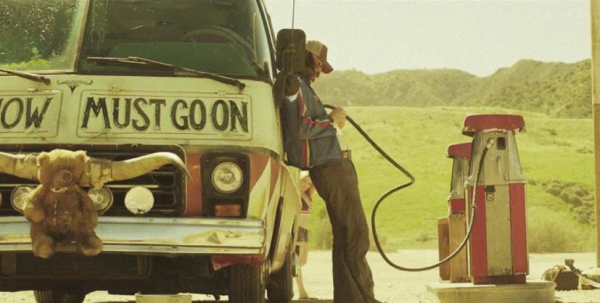
The title of Rob Zombie’s latest foray into his own unique brand of killbilly carnival horror, 31, refers to a deadly game staged once a year on Oct. 31, Halloween. The game is overseen and enjoyed by a few elderly elite, dressed, powdered and wigged in white, like old French aristocrats, who kidnap a group of five people and set them loose inside a murder maze populated with psychotic clown-like killers, all for the purpose of macabre entertainment mixed with a healthy dose of gambling. Think The Hunger Games but less garish, The Running Man but less fun.
Set in 1976—because, even if it wasn’t, that’s Rob Zombie’s aesthetic and it would look like it was regardless—the five kidnapees are a ragtag bunch of bell-bottomed, side-burned, dope-headed carnies, nearly indistinguishable from the Firefly gang or other antagonists/antiheroes of Zombie’s earlier films, except this time they’re the victims. They are Zombie’s obligatory bride-muse, Sheri Moon Zombie, the Jamaican-accented Lawrence Hilton-Jacobs, Jeff Daniel Phillips looking like a young, long-haired Sid Haig, Kevin Jackson and a ripped, ice-eyed Meg Foster, who needs to be cast as an older Sarah Conner post-haste. That the heroes up for slaughter aren’t all vacuous models in their early twenties is undeniably refreshing, though the acting isn’t much better for it, save for Meg Foster.
Once these men and women are captured, Rob Zombie plays every card in his deck, seeming to relish returning to his roots, the maniacal mayhem of the under-loved House of 1,000 Corpses and the critical-darling follow-up The Devil’s Rejects. At least he’s having fun. After the third or fourth variation of pick-a-theme killer clown and the third or fourth nail-bat fight, the tedium begins to set in. Zombie is, if anything, an aesthetician, and his love of ’70s grindhouse and giallo come through, but they come through the seemingly inescapable filter of his past, namely the ’90s music video.
Another trope trapped in the ’90s is 31’s relentless misogyny. The film seems to operate under the delusion that it’s feminist at times, then uses naked women, both dead and alive, as background scenery. Furthermore, the excellent albeit disturbing designs and aesthetics of each villain are undercut whenever they open their mouths, spouting threats of sexual violence with such frequency one wonders if they’re insecure about how scary they are and are desperately trying to compensate with nasty language. The film echoes the insecurity of its villains with excessive folly effects and sound design. And really, 31 isn’t all that scary (see Green Room for a truly terrifying take on the trapped-and-hunted genre).













